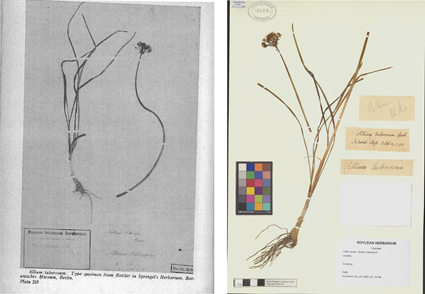Abstract
N/A
References
- Dasgupta, S. (2006) Alliaceae, Liliaceae, Trilliaceae & Uvulariaceae. In: Singh, N.P. & Sanjappa, M. (eds.) Fascicles of Flora of India. Vol. 23. Botanical Survey of India, New Delhi. pp. 1–134.
- Friesen, N. (2023) Introduction to edible Alliums: Evolution, Classification and Domestication. In: Rabinowitch, H.D. & Thomas, B. (Ed.) Edible Alliums: Botany, Production and Uses. CAB International: USA.
- Khassanov, F.O. & Yussupov, Z. (2022) Revision of the Genus Allium L. (Amaryllidaceae) in the Flora of India. In: Öztürk, M., Khan, S.M., Altay, V., Efe, R., Egamberdieva, D. & Khassanov, F.O. (eds.) Biodiversity, Conservation and Sustainability in Asia. Vol. 2: Prospects and Challenges in South and Middle Asia. pp. 377–402. https://doi.org/10.1007/978-3-030-73943-0
- Linnaeus, C. (1753) Species Plantarum: exhibentes plantas rite cognitas, ad genera relatas, cum differentiis specificis, nominibus trivialibus, synonymis selectis, locis natalibus, secundum systema sexuale digestas. Vol. 1. Stockholm: Impensis Laurentii Salvii, pp. 294–301. https://doi.org/10.5962/bhl.title.59734
- POWO. (2023) Plants of the World Online. Facilitated by the Royal Botanic Gardens, Kew. Published on the Internet: http://www.plantsoftheworldonline.org/ (Retrieved 21 July 2023).
- Pandey, A., Pradheep, K. & Gupta, R. (2014) Chinese chives (Allium tuberosum Rottler ex Sprengel): a home garden species or a commercial crop in India. Genetic Resources and Crop Evolution 61: 1433–1440. https://doi.org/10.1007/s10722-014-0144-z
- Sprengel, C. (1825) Systema Vegetabilium, Sumtibus Librariae Dieterichianae, Gottingae. ed. 16. Vol. 2. 939 pp.
- Stafleu, F.A. & Cowan, R.S. (1985) Taxonomic literature, ed. 2, vol. 5. Utrecht, Bohn, Scheltema & Holkema. https://doi.org/10.5962/bhl.title.48631
- Stearn, W.T. (1946) Nomenclature and synonymy of Allium odorum and A. tuberosum. Herbertia 11: 226–245
- Turland, N.J., Wiersema, J.H., Barrie, F.R., Greuter, W., Hawksworth, D.L., Herendeen, P.S., Knapp, S., Kusber, W.-H., Li, D.-Z., Marhold, K., May, T.W., Mcneill, J., Monro, A.M., Prado, J., Price, M.J. & Smith, G.F. (Eds.) (2018) International Code of Nomenclature for algae, fungi, and plants (Shenzhen Code) adopted by Nineteenth International Botanical Congress Shenzhen, China, July 2017. Regnum Vegegetabile 159. Koeltz Botanical Books, Glashütten. https://doi.org/10.12705/Code.2018
- Turner, I.M. (2022) From Tranquebar to Madras and back again, again: Typification of the plant names published in Rottler’s account of an Indian Journey in 1799–1800. Taxon 71 (2): 447–458. https://doi.org/10.1002/tax.12662


